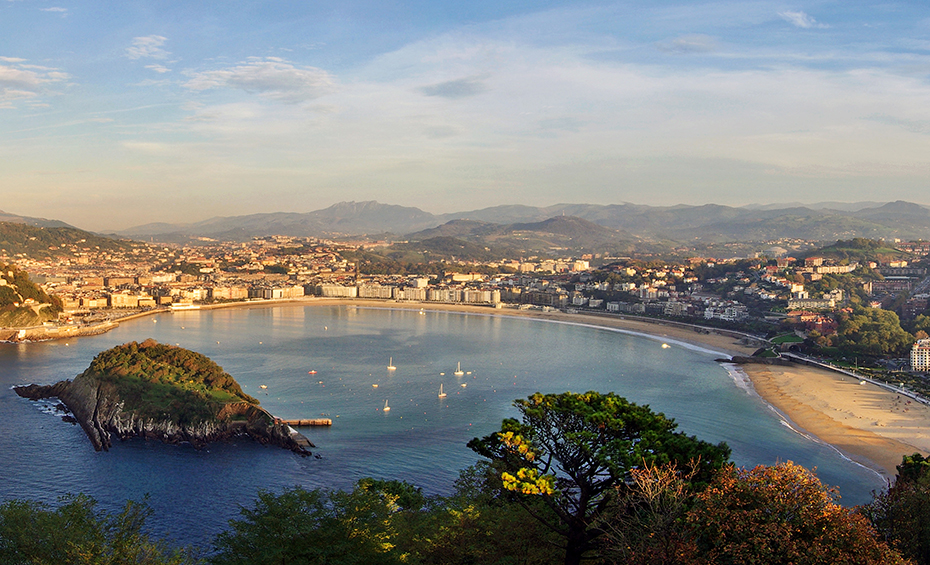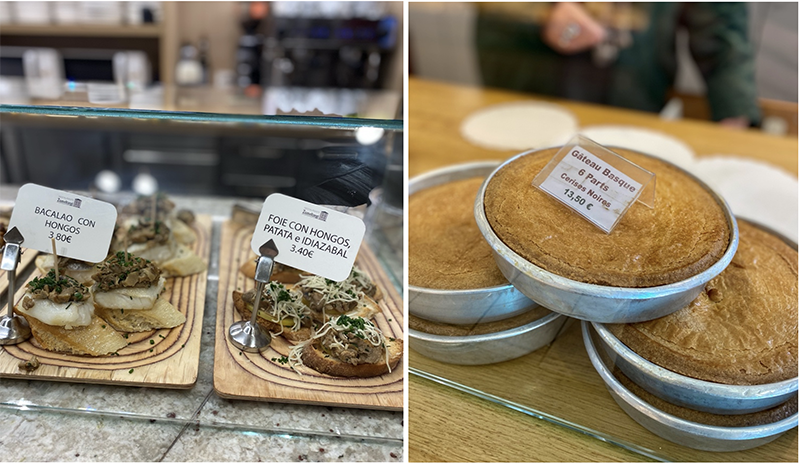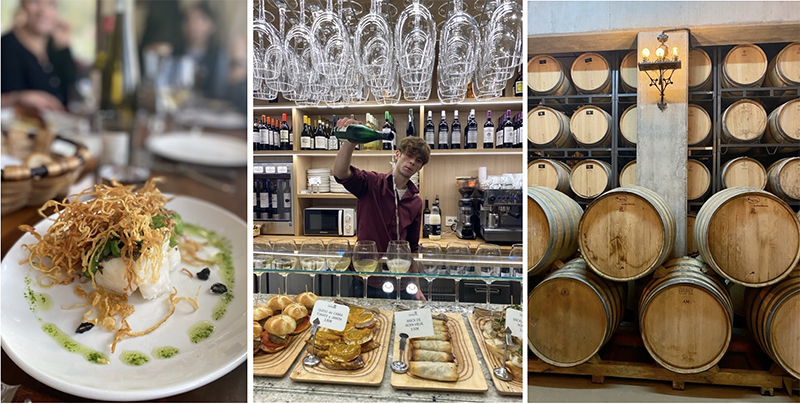POST
January 03 , 2025
How to Discover the Basque Country
Don’t overlook this multi-faceted region on the edge of Spain and France

The ‘Basque Country’ refers to a small area on the border of Spain and France where the Basque language (Euskara) is spoken. Neither Spanish nor French, the destination is a hard one to put your finger on, but it’s not hard to understand why you should visit!
Imagine an area roughly the size of Connecticut, bounded by the Atlantic coast, the Pyrenees peaks, and a massive valley of vineyards to the south. The charming fishing villages with their backdrop of emerald cliffs remind you of the Irish coast, while the contemporary art and gastronomic prowess of the cities is befitting of any modern European capital.

.jpg)
Among the seven historic provinces of Euskal Herria – ‘the land of Basque speakers’ – some people feel more Basque than others. Emotions around identity and independence can run high – the Basque people have managed to hold on to their singular heritage through centuries of outside influence and a period of oppression. Having a guide and choosing local experiences is a guaranteed way to better understand and connect with this fascinating pocket of culture spanning Spain and France.
This region is no great secret to tourists, but most visitors tend to stick around Bilbao and San Sebastian, and you’ll see that it’s worth taking the time to explore outside the main cities.


If you’re already in Spain, you’ll probably be taking a high-speed train from Madrid, or you can opt for a domestic flight into Bilbao or San Sebastian’s airport. If you’re coming from elsewhere in Europe, then you can fly straight into Bilbao. Coming directly from across the ocean, you’ll most likely be flying into Madrid, Barcelona, or even Paris first.
Visit this region as part of a longer itinerary in Spain or France, or come for a week to really discover the best of the Basque. There’s so much to do you won’t regret spending all your time here! Just to prove it, these are our favorite ways to discover the Basque Country …
Get to Know a Living, Ancient Heritage
The Basque genes have been linked to early Neolithic farmers, whose descendants remained puzzlingly isolated from surrounding groups as other hunter-gatherer populations began to migrate and mix. Therefore, the Basque people can claim one of the oldest cultures in Europe, and a language unlike any other in the world.
The Basque language, Euskara, is the defining cornerstone of the region. This pre-IndoEuropean language isolate is un-related to Spanish or French. With mysterious origins, the language still persists today, in many different dialects, and seeming to make generous use of k’s and x’s. Like Catalan, the Basque language wasn’t allowed to be spoken during the Franco dictatorship in the 20th century. It was re-instated as the official language (along with Castilian) of the Spanish Basque region in 1978.
Even though Euskara is an important language, most people do speak Spanish regularly. So you can still get by when you want to use your Spanish skills, and also French to the north.


Today, the vibrant Basque culture is also celebrated with unique traditions like bertsolaritza (improvised singing) and pelota (a unique sport), and festivals including Semana Grande in Bilbao or Tamborrada in San Sebastián.
Feast on Culinary Excellence
No matter what language you speak, the most important language here is food! Whether a coveted reservation at a Michelin-star venue, or an impromptu meal of pintxos at a bar, the cuisine is the main reason many visitors come to the region. Biscay style cod, squid ink delicacies, seafood stew with tuna and potatoes, Idiazábal cheese, great slabs of grilled steak, wines and ciders (more on that later) – the flavors speak louder than words when relaying the Basque Country’s richness of rolling fields and sparkling coasts.


The world’s best chefs clearly have a thing for San Sebastián, and its environs are home to one of the largest concentrations of Michelin stars in Europe. There are four 3-star Michelin restaurants with an hour of San Sebastián (one is outside of Bilbao).
The most fun thing about the Basque diet is pintxos (pinchos)! Who doesn’t love bite-sized food? Let’s get one thing straight for our Basque friends – pintxos are not tapas. Tapas are typically small-plate portions, while pintxos are served as individual portions. Traditionally, pintxos were speared, or ‘pinched’, together with a kind of toothpick, but with modern pintxos you’ll find a wide variety of presentations that don’t require the skewer.


Tapas are meant to be shared, while pintxos are ordered individually. That being said, going out for a pintxo night is still something enjoyed as a group and with friends.
Get Outdoors in Astonishing Landscapes
Come for the food, but fall in love even more with the Basque region’s stunning natural beauty. Snow-capped mountains - the Pyrenees foothills - harbor deep forests of black pine, ash and oak, while a rugged coastline is punctuated by sandy bays and dramatic cliffs that extend to rolling green hills of grazing herds. In between the spacious, sparkling beaches of San Sebastián and Biarritz is a coastline harboring pretty coves and spots for swimming, kayaking, paddleboarding and surfing.


Hiking is a very popular pastime in the region, and a long Sunday trek is often rewarded by a hearty meal in the cider house. The Flysch Route is an excellent option for a day hike – this idyllic coastal trail of green-blue panoramas makes its way through the Basque Coast Geopark, a UNESCO-protected site between the charming towns of Zumaia and Mutriku on the Cantabrian Sea.
The most Instagrammed location is the tiny island of San Juan de Gaztelugatxe just off the coast of Bizkaia. However, ‘Game of Thrones’ fame means this spot is in high demand, and reservations are required in high season.
Enjoy Beautiful Old Towns & Villages
Most visitors choose to base their stay in Bilbao and San Sebastián, and possibly Biarritz for an extended stay. From these points, you have the chance for a number of fulfilling day trips and detours in between.
Bilbao, with its international airport, is the gateway to the area for most visitors. A modern town with a wide shopping avenue leads the way into the narrow medieval lanes of the old quarter, teeming with pintxo bars and street cafes.
.png)

While there are many architectural gems scattered throughout the territory – from futuristic wineries to Belle Époque Biarritz to the fantastic red-and-white, half-timbered facades that characterize the French Basque towns – Bilbao’s Guggenheim is the king of them all, the most-recognized icon of the Basque region. Built in the late 90s, Frank Gehry’s undulating ocean liner of a building transformed the city from an industrial wasteland to an energetic cultural center.



From Bilbao, you could take a day trip to Pamplona, an important town along the Camino de Santiago, where every July the Running of the Bulls draws huge crowds during the festival of San Fermín. Along this route, you can also stop in the modern city of Vitoria-Gasteiz (smaller than Bilbao but the de facto capital of the Spanish Basque region), a good way to get a more comprehensive idea of the region.

In the Spanish territory, the ‘Pais Vasco’, there are a string of small towns leading you from Bilbao to San Sebastián. First there’s the enclave of Gernika, once obliterated from the map by bombs during the Spanish civil war, but today a symbol of peace owing to Picasso’s famous painting ‘Guernica’, which hangs in Madrid’s Reina Sofia Museum.
Out at the coast, you can enjoy picturesque seaside resorts like Elantxobe and Lekeitio. A bit futher along is the small fishing village of Getaria, the hometown of designer Cristobal Balenciaga, with a museum in honor of his couture.

Then you come to San Sebastian (or Donostia), the pride of the Bay of Biscay for all the gastronomic reasons mentioned above, as well as its stretch of golden beach, La Concha, a frolicking summer playground.

On another day, you can take a rental car or a guided excursion to venture across the border into France. First, don’t miss the chance to stop for a refreshment in Hondarribia, a traditional sea-faring village with cobblestone streets, medieval walls and great restaurants.


Then you’ll come to Saint-Jean-de-Luz, a fairytale confection of peppermint-hued half-timbered buildings, plus the church where King Louis XIV of France married the Infanta Maria Theresa of Spain. This is a great town in its own right for a beach vacation, with plenty of attractive shops and eateries.


Just 30 minutes farther north is the small city of Biarritz, a seductive mix of ritzy glamour with laid-back surfer vibes – the epitome of that natural, sun-kissed French chic. If you’re staying a night in Biarritz, it’s also worth taking some time to explore the urban-medieval scene of Bayonne – this is the capital of the ‘Pays de Basque’, sprawled across the rivers Adour and Nive.


Celebrate with Wine & Cider
We’ve mentioned how the Basque people live for food, but the cuisine goes hand in hand with wine and cider, and the traditions surrounding all these beloved dietary staples.
The north of Spain is one of a handful of destinations where you’ll find a long-standing tradition of fermenting apples into hard cider. But of course, it wouldn’t be Basque cider if it weren’t unique. No sugar or yeast is added in the production process, resulting in an acidic, flat, and refreshingly tart beverage. You can get an idea about what Basque cider is from its name, sagardoa, which literally means ‘apple wine’.
The exciting part of visiting a cider house is lining up to ‘catch’ the spout of liquid cider as it shoots from the barrel. This method of ‘throwing’ or pouring the cider from a significant height imparts a bit of natural carbonation to the still beverage. According to cider house rules, sagardoa should be consumed in small portions to preserve the optimum aromas.


Basque cider houses are welcoming countryside hangouts, particularly on the weekends, where you’ll find local families and friends gathered for a feast featuring cod omelets, local cheeses, farm-fresh produce, and huge rib steaks. If you order one of these txuleta, don’t be afraid to send it back for another round on the grill – the locals prefer it very rare!


In addition to the cider houses, you can also find a comforting meal in a txakoli, a rural wine house that serves up simple, traditional meals alongside wine. In the coastal areas that are protected by harsh weather from the mountain slopes, the vineyards grow grapes that are made into txakoli (pronounced cha-kohlee), a refreshing, slightly sparkling white wine.

Wine lovers can’t miss the wine region of Rioja Alavesa (part of La Rioja, Spain’s most important wine area). Take a day trip from Bilbao to discover the surprising wines and architecture of this area. The cute medieval town of Laguardia is a must-see, as well as the whimsical Frank Gehry-designed hotel of the Bodegas Marqués de Riscal in Elciego or the Bodegas Ysios conceived by Calatrava.

The Basque Country is a destination like no other – from the dramatic coastline to charming villages to creative foodie cities, the region promises delight for every traveler. Let us help you craft your perfect custom itinerary to Spain and France, ensuring you discover this region to its full potential. Your Basque adventure awaits – let’s make it unforgettable!